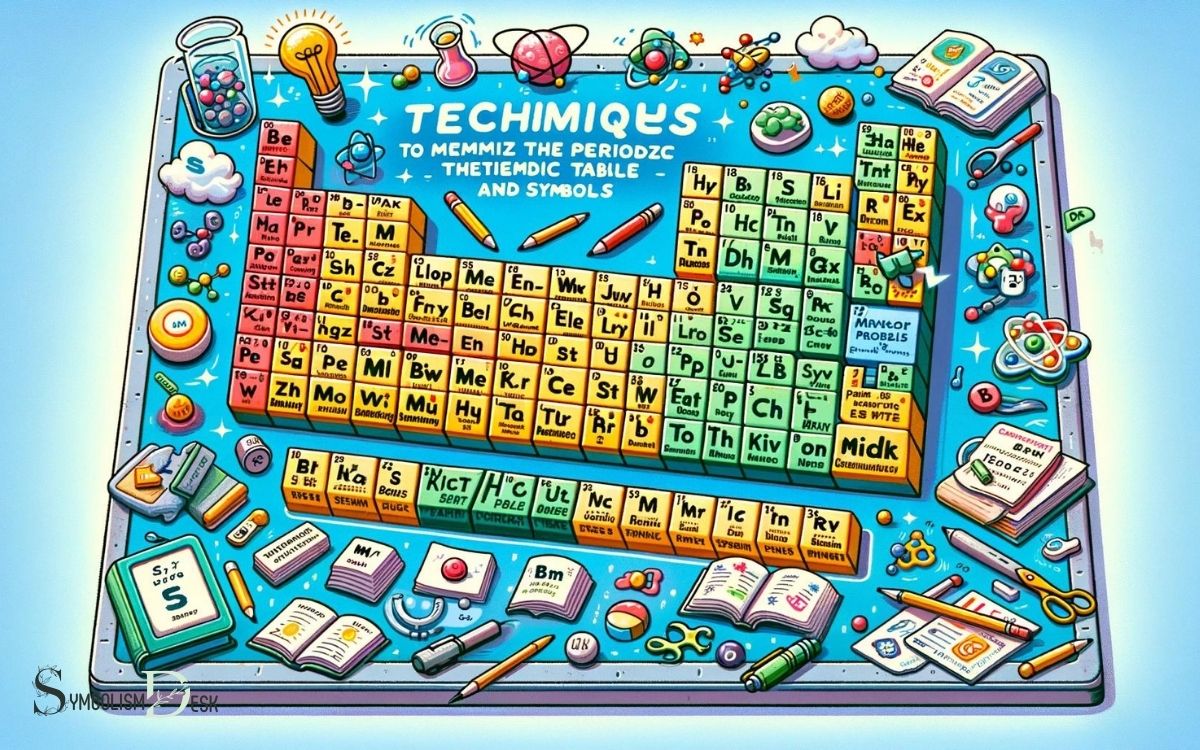How to Memorize the Periodic Table Names and Symbols?
To effectively memorize the periodic table names and symbols, employ strategies such as mnemonic devices, categorization, flashcards, interactive learning, and visualization. Consistent practice is essential for retention.
Memorizing the periodic table can be simplified with techniques that cater to different learning styles:
Mastering the periodic table elevates your understanding of chemical elements and their interactions.

Key Takeaway
Effective Strategies to Memorize Periodic Table Elements and Symbols
| Group | Elements | Mnemonic Phrase |
|---|---|---|
| 1A (Alkali Metals) | H, Li, Na, K, Rb, Cs, Fr | “Happy Little Nuns Kneel, Reading Church Sermons Faithfully” |
| 2A (Alkaline Earth Metals) | Be, Mg, Ca, Sr, Ba, Ra | “Beryllium Maggie Can’t Stop Babbling, Right?” |
| 7A (Halogens) | F, Cl, Br, I, At | “Fancy Clowns Bring In Ants” |
| 8A (Noble Gases) | He, Ne, Ar, Kr, Xe, Rn | “He Never Arrived; Karen eXited Early, Running” |
(Note: The mnemonic phrases above are created for the purpose of this example and may not be commonly used mnemonics.)
Understanding the Periodic Table Structure
To comprehend the periodic table structure, it is essential to understand its arrangement of elements based on their atomic number and chemical properties. The table is organized into periods (rows) and groups (columns).
The periods represent the number of electron shells in an atom, while the groups indicate the number of valence electrons. Elements within the same group share similar chemical properties, making it easier to predict their behavior.
Additionally, the periodic table is divided into metals, nonmetals, and metalloids, each with distinct characteristics.
Understanding the periodic table structure provides a foundation for comprehending the behavior and properties of elements.
This knowledge is crucial for various scientific disciplines, including chemistry, physics, and biology, and is fundamental for anyone aiming to grasp the nature of matter and its interactions.
Utilizing Mnemonics for Easy Recall
In the process of mastering the periodic table names and symbols, mnemonics can serve as powerful memory aids. By employing mnemonic techniques, individuals can enhance their ability to recall the vast array of elements and their corresponding symbols.
The following discussion will explore practical methods for creating and utilizing effective mnemonics in the context of memorizing the periodic table.
Mnemonics Aid Memorization
Mnemonics provide an effective strategy for memorizing the names and symbols of elements in the periodic table. By using mnemonic devices, learners can simplify complex information and improve retention.
Here are three ways mnemonics aid memorization:
- Enhanced Recall: Mnemonics create vivid and memorable associations, making it easier to recall information when needed.
- Reduced Cognitive Load: By providing a mental shortcut, mnemonics alleviate the burden on working memory, allowing for smoother retrieval of information.
- Engaging Learning Experience: Mnemonics add an element of fun and creativity to the memorization process, fostering a positive and enjoyable learning environment.
Incorporating mnemonics into the study of the periodic table can lead to more efficient memorization and deeper understanding of the elements’ names and symbols.
Techniques for Effective Mnemonics
One effective approach for enhancing memorization of the periodic table names and symbols involves employing specific mnemonic techniques that facilitate easy recall.
Mnemonics are memory aids that help individuals remember complex information through the use of associations, patterns, or acronyms.
One technique is the use of acronyms, where each letter represents the first letter of a word in a list. For example, to remember the first five elements (Hydrogen, Helium, Lithium, Beryllium, Boron), one might use the acronym “H He Li Be B” to aid recall.
Another mnemonic technique is visualization, where individuals create vivid mental images related to the information they are trying to remember.
By associating elements with familiar objects or creating a story around them, the brain can more easily retain the information. These techniques can significantly improve the memorization of the periodic table names and symbols.
Breaking Down Elements Into Groups
Grouping elements in the periodic table allows for easier identification of their properties and behaviors.
This categorization into groups helps in understanding the trends and patterns in their characteristics. Breaking down elements into groups provides a systematic approach to studying and memorizing the periodic table.
Here’s why this is important:
- Clarity: Grouping elements helps in creating a clear mental map of the periodic table, making it easier to remember and recall the properties of elements.
- Understanding: By organizing elements into groups, it becomes simpler to comprehend the relationships and similarities between different elements, aiding in a deeper understanding of their behaviors.
- Efficiency: Grouping elements facilitates a more efficient way of learning and memorizing the periodic table, saving time and effort in the process.
Creating Flashcards for Quick Review
How can flashcards be effectively created for quick review of the periodic table names and symbols? Flashcards are an excellent tool for memorization and quick retrieval of information.
To create effective flashcards for the periodic table, follow these steps:
| Name | Symbol | Atomic Number |
|---|---|---|
| Hydrogen | H | 1 |
| Helium | He | 2 |
| Lithium | Li | 3 |
| Beryllium | Be | 4 |
| Boron | B | 5 |
Engaging in Interactive Quizzes and Games
Engaging in interactive quizzes and games can make the process of memorizing the periodic table names and symbols more enjoyable and effective.
By incorporating fun learning activities, such as quizzes and interactive games, individuals can boost their retention of the periodic table information.
These interactive methods provide an engaging way to interact with the periodic table, making the learning experience more dynamic and memorable.
Fun Learning Through Quizzes
Through interactive quizzes and games, learners can engage in fun and effective methods for memorizing the periodic table names and symbols. This approach not only makes the learning process enjoyable but also enhances retention and recall.
Here are three ways interactive quizzes and games can benefit learners:
- Engagement: Interactive quizzes and games promote active participation, creating a more engaging learning experience compared to traditional memorization methods.
- Motivation: The element of competition and achievement in quizzes and games can boost learners’ motivation, making the memorization process more enjoyable and rewarding.
- Retention: By associating periodic table names and symbols with interactive quizzes and games, learners can improve their memory retention through repeated exposure in a stimulating environment.
Interactive Games Boost Retention
By participating in interactive quizzes and games, learners can effectively boost their retention of periodic table names and symbols. Interactive games provide an engaging way for learners to test their knowledge and reinforce their understanding of the periodic table.
These games can range from digital matching games that require players to match element names with their symbols, to interactive quizzes that challenge learners to recall elements based on their properties or characteristics.
By actively participating in these activities, learners are able to apply their knowledge in a practical context, which can significantly enhance their memory retention.
Furthermore, the competitive and interactive nature of these games can make the learning process more enjoyable, leading to increased motivation and engagement, ultimately resulting in better retention of the periodic table names and symbols.
Engage With Periodic Table
Participating in interactive quizzes and games related to the periodic table allows learners to actively engage with the subject matter and reinforce their understanding of element names and symbols.
This approach not only makes the learning process enjoyable but also enhances retention and recall.
Here are three ways engaging with the periodic table through interactive quizzes and games can benefit learners:
- Increased Motivation: Interactive quizzes and games make the process of memorizing the periodic table more enjoyable and engaging, thereby increasing motivation to learn.
- Enhanced Retention: Actively participating in quizzes and games helps reinforce memory retention, making it easier to recall element names and symbols.
- Deepened Understanding: Engaging with the periodic table through interactive mediums fosters a deeper understanding of the elements and their placement, leading to a more comprehensive grasp of the subject matter.
Incorporating Visualization Techniques
To effectively incorporate visualization techniques for memorizing the periodic table names and symbols, it is essential to utilize a systematic approach that aligns visual cues with specific elements.
One effective method is to create a visual mnemonic for each element, connecting its name or symbol with a memorable image or scenario.
For example, for the element Carbon (C), you could visualize a coal miner with a pickaxe, representing the element’s association with coal and mining.
Another technique is to create a visual chart that pairs each element’s name and symbol with a corresponding image, helping to reinforce the associations in your memory. This method not only engages your visual memory but also makes learning more enjoyable. You can even personalize the chart by incorporating themes that interest you, such as animals or nature. For example, if you’re brainstorming hay day farm name ideas, you might use images related to farming alongside the elements, creating a unique and memorable study aid.
Below is an example of how such a visualization chart could look:
| Element | Name | Symbol | Visual Cue |
|---|---|---|---|
| Carbon | Coal | C | Coal miner |
| Oxygen | Air | O | Breath |
| Sodium | Salt | Na | Salt shaker |
| Iron | Metal | Fe | Iron bar |
By incorporating these visualization techniques, you can enhance your ability to remember the periodic table names and symbols.
Practicing Regular Repetition and Review
Incorporating visualization techniques for memorizing the periodic table names and symbols is only the beginning; to solidify this memorization, regular repetition and review are crucial.
To effectively commit the elements to memory, consider the following:
- Consistent Practice: Dedicate a specific time each day to review the periodic table names and symbols. Consistency is key to reinforcing memory retention.
- Utilize Flashcards: Create flashcards with the names and symbols of the elements, and regularly quiz yourself. This method engages active recall, aiding in long-term memorization.
- Teach Others: Explaining the periodic table to someone else can reinforce your own understanding. Teaching others not only solidifies your knowledge but also fosters a sense of accomplishment.
Conclusion
Memorizing the periodic table names and symbols may seem like a daunting task, but with the right techniques and consistent practice, it can become a manageable and even enjoyable process.
Who knew that a chart of chemical elements could become a source of fascination and intrigue? Embracing the challenge of memorization can unlock a whole new world of knowledge and understanding, making it a worthwhile endeavor for any student of science.






